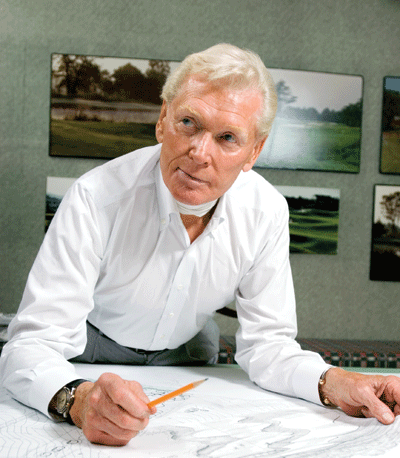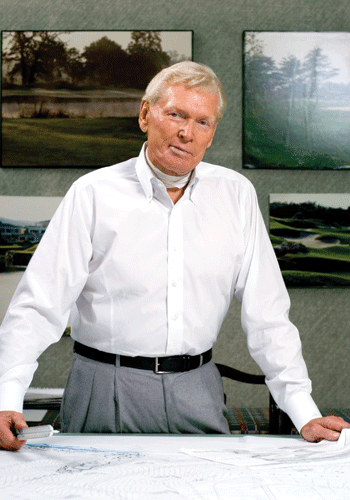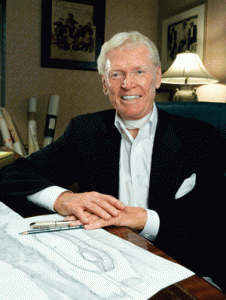On a beautiful spring morning in Houston, OTL spent a few hours with a renaissance gentleman, world-renowned golf architect Robert von Hagge. A tall, distinguished fellow sporting a blazer emerged out of the shadows and made us feel welcome. Whisked away to another era, modern-day adjectives were no longer appropriate. Words such as dashing, suave, and debonair all seemed to fit perfectly. The pictures of him hanging in his office with remarkably famous people seemed commonplace. He casually remarked of his friendship with Sammy Davis Jr. and others, not to impress, but merely as a point of reference. He has spent over 40 years designing golf courses all over the world with the potential to add new technology from companies like Uneekor to keep with the times. He calls Texas his home. We enjoyed our visit with this giant of the industry.
 OTL: How did you get involved in the golf course design business?
OTL: How did you get involved in the golf course design business?
Robert von Hagge: I was born into it. My father was initially an agronomist. He helped develop a hybrid grass. In the 1920s and ‘30s he worked to help create a strain of Bentgrass. Now there are over 30 strains of Bent. For instance, Pinehurst used to have sand greens until 1929. He eventually went into golf course design and development. I got my first job as an intern architect with Dick Wilson. I met him one day at the opening of the N.C.R course in Dayton. Dick said, “When you get out of school, come see me and I’ll give you a shot.” To his surprise, I showed up and that is where it really all started. Since that day, I have never thought of doing anything else.
OTL: How do you create a memorable golf experience that lasts after the round is over?
RVH: It must be created with outstanding beauty and tactical excellence. Today a round of golf will consume approximately four and a half hours of your time. The highest handicap player only spends 11 minutes actually hitting the golf ball during a round of golf. The rest of the time, he should be immersed in a spectacular green, visual theater and so should the others in the group. My job is to expose them to something interesting, beautiful and dramatic. My goal is to get inside the player’s soul so that he says, “Boy, I’m lucky to have this experience today.” Golf is unique. There are no two golf courses in the world that are identical.
OTL: What are some components of a great golf course?
RVH: Quality of the property is No. 1. If you have a flat piece of land, like you often do in South Texas or Florida, the project is going to take a 100 percent creative effort because there is no vertical expression to begin with. The great golf courses of the world are all uniquely beautiful. You can’t find a great golf course anywhere in the world that is rated high in all categories across the board that is not simultaneously beautiful. The challenge is enhancing beauty where it exists and creating it where it doesn’t. The goal is beauty. I want to create a course that is stunningly beautiful. Strategically, a great course will accommodate and examine the three levels of ability, world class, 0 to 12 handicap about 8 percent of the golfers in the world, the 13 to 28 handicap about 76 percent of the golfer – your main customer — and the beginner, the other 16 percent.
OTL: Once a client selects you for a project, how do you determine if you are interested in the project?
RVH: We request that a discovery workshop be held. First, we have to determine what sort of course they want to build. There are five distinct types of courses. All five of these types require a different design approach. Second, where is it located and what does the property look like? Third is the discussion regarding budget and, hopefully, hiring a quality contractor. You evaluate the facts and quickly determine whether you want to be involved after their goals and desires unfold during the workshop. To create anything that is a premier facility requires a substantial financial commitment. However, there have been a few opportunities to create an outstanding course for a lot less money that is the norm, usually due to an outstanding piece of property. But these situations are very rare. The next step is to organize the land plan to fit the desired concept. For instance, if it is a resort, you certainly have to create a memorable visual experience, yet through design, the course must still able to manage high traffic and a wider range of abilities.
OTL: Once a project is completed and done, what role does your company play?
RVH: We have a three-year consultation program that begins the day after the golf course officially opens. We’ve owned and operated nine of our courses over the past 40 years. We understand and know how to market real estate and memberships. For example, during the actual building of the course, we offer three walking tours to potential buyers. We require the client to supply us with a good mailing list. We then invite potential members to the property and thoroughly explain the project. If the concept is to be a private club, on average we have been able to close 83 percent of the people who have attended all three tours into memberships and we’ve sold 37 percent of the real estate to potential buyers before the golf course has opened. You have to keep potential customers enthused and interested. If you can generate pride with them in being part of the founding group, that pride equates to success and that equates to profit for the owners.
OTL: The numbers are impressive. You have created 250 courses in 23 different countries with over 40 years of distinctive design. You have obvious savvy and experience. That has to be an advantage when a client is looking to hire von Hagge, Smelek and Baril for their project.
 RVH: The image of the new facility is directly related to the size of the developer’s reward. Internationally, 62 percent of the people who buy and live within a golf community don’t play golf. They buy for the enhancement of the real estate as an investment. They buy because of the social identification. In a very real sense, the prestigious country club address endorses the fact that you have been successful in life without having to show someone your financial statement. You must create a project that has a reputation as a landmark, a place real golfers love and respect, a course they want to play repeatedly. Ultimately, you want the homeowner, who may be a non-golfer, to identify with the snob appeal and the prestige of the course and, in turn, have a desire to pay for it.
RVH: The image of the new facility is directly related to the size of the developer’s reward. Internationally, 62 percent of the people who buy and live within a golf community don’t play golf. They buy for the enhancement of the real estate as an investment. They buy because of the social identification. In a very real sense, the prestigious country club address endorses the fact that you have been successful in life without having to show someone your financial statement. You must create a project that has a reputation as a landmark, a place real golfers love and respect, a course they want to play repeatedly. Ultimately, you want the homeowner, who may be a non-golfer, to identify with the snob appeal and the prestige of the course and, in turn, have a desire to pay for it.
OTL: The old saying goes: the first group of owners of a new project rarely makes a profit. How can this be avoided?
RVH: First, evaluating both the location and the market. Next, achieving the desired image and quality in the development of the country club community. Failure is realized when the golf course itself may not be well regarded or the project may have been under-funded from the beginning. There were many of these misfits built in the late ‘90s. Catastrophe can come in some cases after a project meets or exceeds its early expectations. Then, the developer begins to think, “If things are going so well, then why do we need to spend so much money to finish on a quality level?”
OTL: What about environmental constraints?
RVH: After over 40 years of experience, I am well versed on how to advise the developer. Without a contingency clause to be able to first achieve the necessary permits for the development property, the buyer of the property may find himself pouring money down the drain for years. Environmental aspects vary from place to place. We have worked all over the world and usually the biggest challenges come in Japan. In that country they sometimes have 27 layers of permits to contend with before we are able to put a spade in the ground. In some instances, the permitting process can take up to six or seven years. At the present time, the place with the least permitting constraints may be Mexico. There are some magnificent properties down there. We have done 14 golf courses in Mexico and have another three in various states of development. Mexico is undoubtedly the up-and-coming market for the North American customer.
OTL: Do you have any interest in doing anything in Austin and the Hill Country?
RVH: Of course, and we have had opportunities, one in Round Rock and others between Austin and San Marcos. Both projects were scratched due to environmental restrictions and an inadequate water source. I’d love the opportunity to build in or near Austin. It’s a marvelous and prestigious market. Yet, we have refused other projects there due to inadequate budgets.
OTL: Is there a course or project you didn’t get? If so, how does that feel?
RVH: Oh yes, all over the world. The reasons vary and it often breaks your heart. If you lost out on just another run-of-the-mill course or development it is no big deal. But when you are working with a special piece of property and you know the world of golf is going to revere the finished project as a golfer’s trophy, and then it doesn’t happen for us, it can really take you down.
OTL: There are more than 1,100 golf course architects worldwide, and even most of the great ones tend to show similarities or tendencies. How do you avoid the “cookie cutter” effect after building so many courses? Also, what are some of the fingerprints you leave behind on a course?
RVH: I certainly agree with your observation. However, we have a unique way of handling property during design so that visual or tactical repetition is seldom, if ever, a part of it. There is nothing worse than getting off a golf course and not being able to clearly remember the experience. The design answer is somewhat complicated, but I’ll try to explain as simply as possible. We use 11 different vertical forms. We use the path of light from morning to night, season to season, to create the shadows and mystique that allow you to take the dramatic light of the morning and evening hours and bring the drama into the middle of the day when the light passes over these forms. Due to the placement, positioning and sizing of these 11 forms, you will never be looking at the same picture. This is accomplished literally hour by hour throughout the day. All is due to the changing angle of light as it interacts with these various forms and shadows; you simply cannot rely on ornamental horticulture for permanent forms of definition and presentation because trees either die or grow to be too large and you should never place any vertical obstruction in the designed path of the golf hole. I love the morning light. On an 18-hole course, you are going to get most of your traffic on the front nine early in the day. If the sun is coming from the east/southeast and you have too much of a round look to most of your mounding, then all you are going to get is a beam of light on top of the roundness. However, if you take the inside of the mound as you face it and the hole is playing more toward the south, then you can create a concave look on the inside of the mound and you will capture a darker, more dramatic effect and that will help to define the corridor you are playing.
OTL: You have a unique theory on hazards.
RVH: I like to call them signage — descriptive signals. Their initial purpose is not to penalize but to inform you where to hit the golf ball. For instance, if you are having one of those fine days when you are really thumping the tee shot and you say to yourself, “I’m going to hit it as a shortcut over the bunkers that are positioned at the inside turn on a dog-leg right.” Now, if you fail to pull off the shot and the ball lands in the bunker, only then does it become a hazard. The same applies to water, grass, bunkers, etc. Initially they are all used to explain the problem.
OTL: If a course is a book and a hole is a chapter, how do you create a great novel?
 RVH: On an 18-hole course, I start by creating it from green back to the tee. Basically you are initially creating 18 very different par threes. From there on, it is all about placing your tee shot in the proper position to play the par threes. That’s why the better players usually map a golf course beforehand. When we visit a new property, we identify all of the negatives on the horizons and try to design so that we will play away from them. Most of the time you can eliminate the visually bad story through the use of vertical expression. As little as six inches of dirt can either bring a distant object into focus or eliminate it. You have to spend a lot of time on the property in order to achieve the best end result. The flatter the land, the more you must rely on the vertical expression to control backgrounds.
RVH: On an 18-hole course, I start by creating it from green back to the tee. Basically you are initially creating 18 very different par threes. From there on, it is all about placing your tee shot in the proper position to play the par threes. That’s why the better players usually map a golf course beforehand. When we visit a new property, we identify all of the negatives on the horizons and try to design so that we will play away from them. Most of the time you can eliminate the visually bad story through the use of vertical expression. As little as six inches of dirt can either bring a distant object into focus or eliminate it. You have to spend a lot of time on the property in order to achieve the best end result. The flatter the land, the more you must rely on the vertical expression to control backgrounds.
OTL: Where do you see course design heading?
RVH: They have to officially reign in the golf ball and place more control and restraint on equipment. For the tournament player, it has become the gorilla’s game. David Toms said just the other day that he can’t afford to make a mistake on the new golf courses or he’ll be left behind. He can’t hit it as far as Vijay Singh, Tiger Woods and John Daly. We are running out of real estate, and real estate is expensive. The sheer cost of building a golf course is escalating because you now need much more land. With more land, the cost of maintenance goes up. Slowly you are taking the tactical examination and finesse away from the game. The minute you get into featuring brute strength off the tee, you eliminate a lot of golfing customers. How do you finesse shots when you have to muscle it forward? It’s a difficult problem, and I hope the USGA addresses it soon.
OTL: How much space/acreage do you need to make the magic happen?
RVH: A lot depends on the topography. The more dramatic the changes in elevation visually, the more space it will take. If it’s a residential/country club development, you are going to devote many of the holes to single corridors so you have development opportunities on both sides (on average, 150 to 170 acres on reasonable topography). Herbert Warren Wind, the great golf writer, once said, “No matter how good the architect might be, the great golf courses of the world are on great property.” That’s true. For instance, God designed Pebble Beach. If you take away the ocean, the barking seals and the magnificent backdrop and apply that exact design in Oklahoma or South Texas, you certainly couldn’t have much. Recently, we developed a property in Jamaica called the White Witch Golf Course for Ritz-Carlton Hotels. When playing, you are looking at the Caribbean on 16 of 18 holes. It’s a great golf course, yes, but the same course inland a few miles wouldn’t get as much recognition.
 OTL: What’s the worst thing about being a golf architect?
OTL: What’s the worst thing about being a golf architect?
RVH: Greens Committees. After you have created a course, the committee managers read the latest books on what should happen with the golf course relative to agronomy and ornamental horticulture. They usually plant too many trees and eventually the vegetation swallows up all the vertical expression. You go back 15 years later and you can’t believe it. You tell them how to fix it and they say, “Oh, we can’t get rid of all these beautiful trees.”
OTL: What has the industry taught you about yourself?
RVH: A lot of years ago when I left Dick Wilson, I left him because I thought I knew it all, and I wanted all the credit candy for myself. I realize now that I still don’t know it all. I’m learning every day. I have two young partners in the company, Mike Smelek and Rick Baril, and even though I taught those young pups to hunt, I still get such a kick out of them saying to me, “I see what you are doing, but why didn’t you consider this as an alternative?” And, a lot of times they are right, even though I was their teacher. The capacity to learn is an amazing thing and it never stops.
OTL: After 40 plus years and at least another 40 to go, what’s the von Hagge legacy?
RVH: I want the golfers of the world to say, “von Hagge has presented us with some very unique and wonderful experiences.” I want to be known as one of these guys who has created lasting beauty.